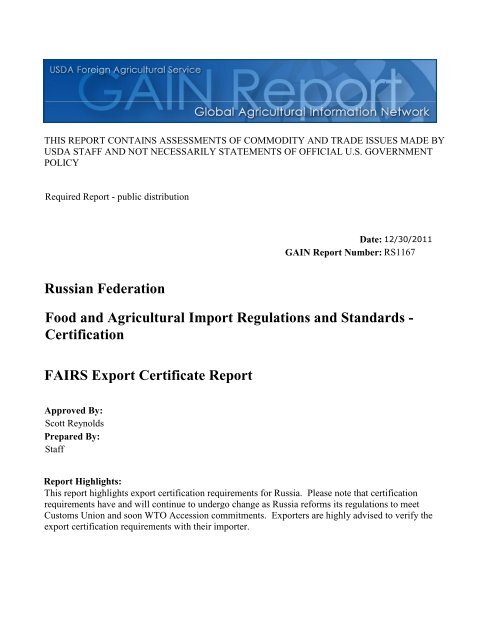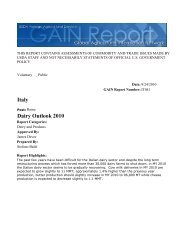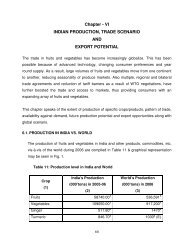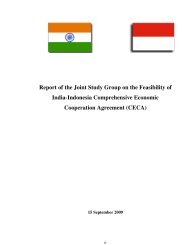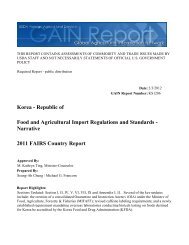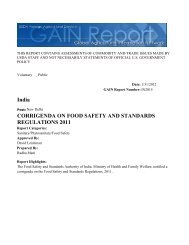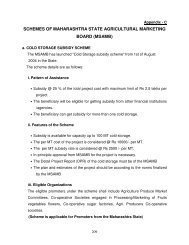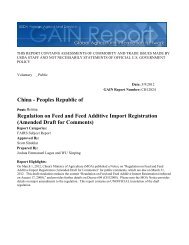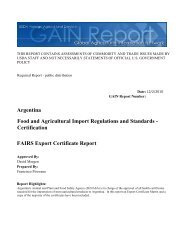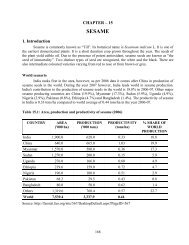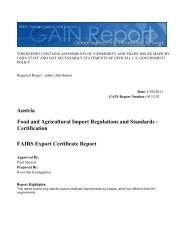FAIRS Export Certificate Report Food and Agricultural Import ...
FAIRS Export Certificate Report Food and Agricultural Import ...
FAIRS Export Certificate Report Food and Agricultural Import ...
You also want an ePaper? Increase the reach of your titles
YUMPU automatically turns print PDFs into web optimized ePapers that Google loves.
THIS REPORT CONTAINS ASSESSMENTS OF COMMODITY AND TRADE ISSUES MADE BY<br />
USDA STAFF AND NOT NECESSARILY STATEMENTS OF OFFICIAL U.S. GOVERNMENT<br />
POLICY<br />
Required <strong>Report</strong> - public distribution<br />
Date:<br />
GAIN <strong>Report</strong> Number: RS1167<br />
12/30/2011<br />
Russian Federation<br />
<strong>Food</strong> <strong>and</strong> <strong>Agricultural</strong> <strong>Import</strong> Regulations <strong>and</strong> St<strong>and</strong>ards -<br />
Certification<br />
<strong>FAIRS</strong> <strong>Export</strong> <strong>Certificate</strong> <strong>Report</strong><br />
Approved By:<br />
Scott Reynolds<br />
Prepared By:<br />
Staff<br />
<strong>Report</strong> Highlights:<br />
This report highlights export certification requirements for Russia. Please note that certification<br />
requirements have <strong>and</strong> will continue to undergo change as Russia reforms its regulations to meet<br />
Customs Union <strong>and</strong> soon WTO Accession commitments. <strong>Export</strong>ers are highly advised to verify the<br />
export certification requirements with their importer.
Introduction<br />
In general, Russia does not accept generic veterinary certificates issued by the U.S. competent<br />
authorities, which certify products in compliance with U.S. st<strong>and</strong>ards. Rather, Russia requires<br />
veterinary certificates to detail several specific attestations in addition to including a catch-all “meets<br />
Custom Union requirements” (previously “meets Russian requirements”), which is generally a challenge<br />
for most commodities. The Russia-Kazakhstan-Belarus Custom Union requirements present<br />
considerable challenges to exporters, as they cover a wide range of goods of both animal <strong>and</strong> plant<br />
origin, are extremely prescriptive, <strong>and</strong> in general are neither based on risk assessments nor international<br />
st<strong>and</strong>ards.<br />
In order to export to Russia, considerable documentation is required from both governments <strong>and</strong> must be<br />
provided in Russian. Cargo is routinely detained for certification errors. <strong>Export</strong>ers who have the most<br />
success in Russia work with experienced brokers or importers. While this report does not provide<br />
detailed information on export health certificates issued by U.S. Government agencies, up-to-date<br />
information is available from the relevant agencies on their websites.<br />
Corruption<br />
Russia is ranked 143 out of 182 countries on the Corruption Perception Index, <strong>and</strong> is tied with nine other<br />
countries with a score of 2.4 out of 10.0. Counterfeiting <strong>and</strong> alteration of shipping documents, including<br />
import permits <strong>and</strong> export health certificates, constitute a serious problem in Russia. Traders are<br />
routinely confronted by both corrupt officials seeking to extort bribes in return for turning a blind eye to<br />
non-existent or obviously fake documents, <strong>and</strong> schemes by dishonest traders to deceive Russian officials<br />
with fraudulent documents. American exporters should be aware that under the Foreign Corrupt<br />
Practices Act <strong>and</strong> other applicable U.S. <strong>and</strong> Russian laws, payment of bribes <strong>and</strong> engaging in or abetting<br />
fraud in the course of a foreign trade transaction is a criminal act.<br />
Transition Period<br />
Russia remains in a transition period as it both reforms its regulations to meet Customs Union <strong>and</strong> soon<br />
WTO Accession commitments.<br />
The final <strong>and</strong> transitional provisions of the Customs Union’s “Uniform requirements of products under<br />
veterinary control” allow imports of products accompanied by veterinary certificates which differ from<br />
the “Uniform Requirements” until January 1, 2013, if they were initialed before July 1, 2010. The<br />
validity of these certificates can be indefinitely extended if the United States requests to renegotiate<br />
them prior to January 1, 2013. Products accompanied by certificates initialed between July 1, 2010 <strong>and</strong><br />
December 1, 2010 may be imported <strong>and</strong> consumed until January 1, 2013 only in the territory of the<br />
initialing Customs Union Party.
Section I. List of All <strong>Export</strong> <strong>Certificate</strong>s Required By Government:<br />
The following export certificates are currently issued <strong>and</strong>/or remain valid in order to facilitate U.S.<br />
exports to Russia. <strong>Export</strong>ers should consult with their importers to determine which certificates are<br />
needed for goods they intend to ship.<br />
Health <strong>Certificate</strong>s – Sanitary (Veterinary)<br />
USDA/Animal <strong>and</strong> Plant Health Inspection Service/Veterinary Services/Animal<br />
Veterinary certificate for breeding cattle exported from United States to the Russian Federation<br />
(approved March 31, 2008)<br />
Veterinary certificate for breeding sheep <strong>and</strong> goats exported from United States to the Russian<br />
Federation (approved December 8, 2009)<br />
Veterinary certificate for breeding pigs exported from the United States to the Russian<br />
Federation (approved March 31, 2008)<br />
Veterinary certificate for slaughter pigs exported from the United States to the Russian<br />
Federation (approved March 31, 2008)<br />
Veterinary certificate for fattening pigs exported from the United States to the Russian<br />
Federation (approved March 31, 2008)<br />
Veterinary certificate for breeding, usage <strong>and</strong> sport horses exported from United States to the<br />
Russian Federation (approved March 31, 2008)<br />
Veterinary certificate for temporary admission of horses from the United States to the Russian<br />
Federation for participation in international competitions for a period less than 90 days<br />
(approved March 31, 2008)<br />
Veterinary certificate for mink exported from United States to the Russian Federation (approved<br />
March 16, 2007)<br />
Veterinary certificate for bovine semen exported to the Russian Federation (approved March 3,<br />
2006)<br />
Veterinary certificate for bovine embryos from United States to the Russian Federation<br />
(approved March 31, 2008)<br />
Veterinary certificate for day-old chicks, turkey poults, ducklings, goslings <strong>and</strong> incubate eggs of<br />
this species exported into the Russian Federation (approved March 29, 2005) [Note: Since the<br />
certificate is not on the VPSS website, this may result in problems crossing the border.]<br />
For more information, visit http://www.fsvps.ru/fsvps/import<strong>Export</strong>/usa/sertificates.html or<br />
http://www.aphis.usda.gov/regulations/vs/iregs/animals/animal_russian_federation.shtml.
USDA/Animal <strong>and</strong> Plant Health Inspection Service/Veterinary Services/Animal Products<br />
Veterinary certificate for hides, horn <strong>and</strong> hoof, furs, sheep pelt, lambskin, wool <strong>and</strong> goat fluff,<br />
bristle, horse hair, down <strong>and</strong> feather of chicken, duck, goose <strong>and</strong> other poultry, <strong>and</strong> technical<br />
gelatin exported from United States to the Russian Federation (approved June 30, 2009)<br />
Veterinary certificate for fresh-dry raw material for fur production exported from the United<br />
States to Russia (approved October 24, 2005) [Note: Since the certificate is not viewable on<br />
the VPSS website, this may result in problems crossing the border.]<br />
Veterinary certificate for non-edible (technical) animal protein-free rendered fats exported to the<br />
Russian Federation (approved November 23, 2004)<br />
Veterinary certificate for import of fodder <strong>and</strong> fodder supplements of animal origin (approved<br />
July 15, 2004)<br />
Veterinary certificate for dog <strong>and</strong> cat feeds exported from United States to the Russian<br />
Federation (approved June 2, 2010)<br />
Veterinary certificate for feed <strong>and</strong> feed additives for non-productive animals, not containing<br />
components of animal origin exported from United States to the Russian Federation (approved<br />
June 30, 2010)<br />
Veterinary certificate for feed for aquarium <strong>and</strong> decorative fishes exported from the United<br />
States to the Russian Federation (approved June 30, 2010)<br />
Veterinary certificate for livestock raw materials, that are not derived from ruminants, <strong>and</strong> meant<br />
for pet food manufacturing, exported to the Russian Federation (approved February 16, 2006)<br />
Veterinary certificate for milk <strong>and</strong> milk products, derived from cattle, exported into the Russian<br />
Federation (approved April 29, 1993) [Note: Since the certificate is not on the VPSS website,<br />
this may result in problems crossing the border.]<br />
Veterinary certificate for non-fat dry milk, derived from the cattle, exported into the Russian<br />
Federation [Note: Since the certificate is not on the VPSS website, this may result in<br />
problems crossing the border.]<br />
For more information, visit http://www.fsvps.ru/fsvps/import<strong>Export</strong>/usa/sertificates.html or<br />
http://www.aphis.usda.gov/regulations/vs/iregs/products/product_russia.shtml.
USDA/<strong>Food</strong> Safety Inspection Service<br />
FSIS Form 9450-3 (04/21/2010) Veterinary certificate for frozen pork meat <strong>and</strong> pork byproducts<br />
exported from the U.S. to the Russian Federation (approved February 27, 2010)<br />
FSIS Form 9450-4 (03/03/2011) Veterinary certificate for export of poultry meat to the Russian<br />
Federation (approved March 10, 2006)<br />
o Letterhead <strong>Certificate</strong> for Pathogen Reduction Treatment Used for Poultry <strong>and</strong> Poultry<br />
Products <strong>Export</strong>ed to the Russian Federation (approved September 2, 2010)<br />
FSIS Form 9450-5 (05/25/2010) Veterinary certificate for beef <strong>and</strong> beef by-products exported<br />
from the U.S. to the Russian Federation (approved November 2, 2006)<br />
FSIS Form 9450-6 (7/95) Veterinary certificate for pork intestine raw material, exported into the<br />
Russia Federation (approved June 23, 1995)<br />
o FSIS Form 9060-7 (8/13/2008) Animal Casings <strong>Export</strong> <strong>Certificate</strong> for Countries<br />
Requiring Ante-mortem, Post-mortem, <strong>and</strong> Fit-for-Human-<strong>Food</strong> Statements<br />
FSIS Form 9450-7 (7/95) Veterinary certificate for prepared meat products exported into the<br />
Russian Federation (approved June 23, 1995)<br />
FSIS Form 9450-11 (03/04/1999) Veterinary certificate for horse meat exported into the Russian<br />
Federation (approved April 20, 1999)<br />
FSIS Form 9450-12 (4/18/2001) Veterinary <strong>Certificate</strong> for Raw Materials of Animal Origin for<br />
Pet <strong>Food</strong> Manufacturing <strong>Export</strong>ed to the Russian Federation [Note: Since the certificate is not<br />
on the VPSS website, this may result in problems crossing the border.]<br />
For more information, visit http://www.fsvps.ru/fsvps/import<strong>Export</strong>/usa/sertificates.html or<br />
http://www.fsis.usda.gov/Regulations_&_Policies/Russia_Requirements/index.asp.<br />
U.S. Department of Commerce/National Marine Fisheries Service<br />
Veterinary certificate for fish <strong>and</strong> sea products of their processing subjected to thermal treatment,<br />
exported to the Russian Federation (approved in 2005)<br />
For more information, visit http://www.fsvps.ru/fsvps/import<strong>Export</strong>/usa/sertificates.html or<br />
http://www.seafood.nmfs.noaa.gov/.
Health <strong>Certificate</strong>s – Phytosanitary<br />
USDA/Animal <strong>and</strong> Plant Health Inspection Service/Plant Protection <strong>and</strong> Quarantine<br />
PPQ Form 577 (Feb 2001) Phytosanitary <strong>Certificate</strong><br />
PPQ Form 578 (Feb 2001) Processed Plant Products<br />
PPQ Form 579 (Feb 2001) Phytosanitary <strong>Certificate</strong> for Reexport<br />
For more information, visit http://www.fsvps.ru/fsvps/import<strong>Export</strong>/usa/phyto.html or<br />
http://www.aphis.usda.gov/import_export/plants/plant_exports/export_certificates_forms.shtml.<br />
USDA/Grain Inspection, Packers <strong>and</strong> Stockyards Administration<br />
LibertyLink Rice Proficiency Program Letter <strong>and</strong> Test Results (to accompany Phytosanitary<br />
<strong>Certificate</strong>)<br />
Other <strong>Certificate</strong>s<br />
Private<br />
<strong>Certificate</strong> of Origin<br />
<strong>Certificate</strong> of Quality (<strong>and</strong> Safety)<br />
U.S. Department of the Interior/US Fish <strong>and</strong> Wildlife Service<br />
Convention on International Trade in Endangered Species of Wild Fauna <strong>and</strong> Flora (CITES)<br />
<strong>Export</strong> <strong>Certificate</strong><br />
Convention on International Trade in Endangered Species of Wild Fauna <strong>and</strong> Flora (CITES)<br />
Reexport <strong>Certificate</strong><br />
For more information, visit http://www.fws.gov/international/DMA_DSA/CITES/CITES_home.html
Section II. Purpose of Specific <strong>Export</strong> <strong>Certificate</strong>(s)<br />
Health <strong>Certificate</strong>s<br />
<strong>Export</strong> certificates are required <strong>and</strong> verified for consistency with Russian-Kazakh-Belarusian Customs<br />
Union regulations at the external border of the Customs Union to protect public <strong>and</strong> animal health<br />
(veterinary certificates) as well as the environment (phytosanitary certificates). Health certificates are<br />
also used to determine product origin.<br />
The Russian Ministry of Agriculture’s Federal Veterinary <strong>and</strong> Phytosanitary Surveillance Service,<br />
(VPSS or Rosselkhoznadzor) is responsible for veterinary <strong>and</strong> phytosanitary control in Russia as well as<br />
on Russia’s external border of the Customs Union. The Russian Ministry of Health’s Federal Service<br />
for the Protection of Consumer Rights <strong>and</strong> Human Well-Being of the Ministry of Health <strong>and</strong> Social<br />
Development (Rospotrebnadzor) is responsible for sanitary-epidemiological control in Russia but is not<br />
located on the border. In practice, VPSS enforces sanitary-epidemiological control over products at the<br />
border when those products are also under sanitary-veterinary control. For product transiting<br />
Kazakhstan or Belarus <strong>and</strong> destined for Russia, sanitary <strong>and</strong> phytosanitary control, including the<br />
verification of valid certificates to enter Russia, is performed at their respective external borders of the<br />
Customs Union.<br />
Veterinary <strong>Certificate</strong>s<br />
According to the Uniform procedure for veterinary control at the customs border of the Customs Union,<br />
products contained in the Uniform list of products under veterinary control require a veterinary<br />
certificate (except veterinary drugs <strong>and</strong> feed additives of chemical <strong>and</strong> microbiological synthesis need<br />
only be accompanied by documents issued by the manufacturer confirming their quality <strong>and</strong> safety).<br />
Veterinary certificates should be consistent with the Uniform requirements of products under veterinary<br />
control as well as the Uniform veterinary certificates for import to the customs territory of the Customs<br />
Union.<br />
Veterinary certificates are also used to enforce the Uniform sanitary-epidemiological <strong>and</strong> hygienic<br />
requirements for products contained in the Uniform list of products under sanitary-epidemiological<br />
control at the customs border <strong>and</strong> in the customs territory of the Customs Union.<br />
Phytosanitary <strong>Certificate</strong>s<br />
According to the Procedure for phytosanitary control at the customs border of the Customs Union,<br />
products defined as “high phytosanitary risk” in the List of products under phytosanitary control require<br />
a phytosanitary certificate.<br />
Other <strong>Certificate</strong>s<br />
<strong>Certificate</strong>s of Quality (<strong>and</strong> Safety)<br />
The manufacturer’s certificate of quality (<strong>and</strong> safety) is used to determine whether the product conforms<br />
to product specifications of the contract <strong>and</strong> quality requirements of the Customs Union <strong>and</strong> Russia. It is<br />
not a substitute for the applicable U.S. Government-issued health certificates. It is, rather, a document<br />
used by the importer to obtain a certificate or declaration of conformity, which attests to compliance<br />
with the sanitary-epidemiological requirements.
<strong>Certificate</strong>s of Origin<br />
Russian Customs officials use certificates of origin as proof to determine import tariffs <strong>and</strong> to prevent<br />
importation of products from countries under import restrictions unrelated to sanitary or phytosanitary<br />
issues.<br />
CITES <strong>Certificate</strong>s<br />
CITES control is guided by Appendices I, II, <strong>and</strong> III.<br />
The export of Appendix-I <strong>and</strong> –II specimens requires an export permit. Such a permit may be<br />
granted when the export will not be detrimental to the species’ survival <strong>and</strong> specimens were<br />
legally acquired.<br />
For Appendix-III species originating from the country that listed it, an export permit is required.<br />
An export permit may be granted when the Management Authority determines that the<br />
specimens were not obtained in contravention of that country’s laws for the protection of animals<br />
<strong>and</strong> plants.<br />
A re-export certificate is required for the export of CITES-listed specimens that were previously<br />
imported, including items subsequently converted to manufactured goods. A certificate may be<br />
issued when evidence of legal import has been provided. If you were the original importer of the<br />
wildlife or plant, you need to provide a copy of the canceled CITES permit that accompanied the<br />
shipment into the United States <strong>and</strong>, for animal specimens, the cleared Declaration for<br />
<strong>Import</strong>ation (Form 3-177) for that shipment. If you were not the importer, you must provide<br />
copies of the importer’s documents, as well as documents that show you purchased the wildlife<br />
or plant from the original importer, or a record of sequential transactions.<br />
If a species meets the criteria for bred-in-captivity or artificially propagated as outlined in CITES<br />
resolutions, the exporting country may issue an exemption certificate (bred-in-captivity facts<br />
sheet is available). For Appendix-I specimens, no CITES import permit is required.<br />
For Appendix-III specimens that originated from a country other than the listing country, a<br />
certificate of origin is needed to export the specimen. A certificate can be issued if the specimen<br />
was legally obtained within the exporting country.
Section III. Specific Attestations Required on <strong>Export</strong> <strong>Certificate</strong>(s)<br />
All certificates must be in Russian.<br />
For products under veterinary control, please consult the importer’s import (veterinary) permit for<br />
specific conditions.<br />
For products under sanitary-epidemiological control, the Customs Union typically requires the<br />
corresponding veterinary certificates contain the following two attestations:<br />
“Microbiological, chemical <strong>and</strong> toxicological, <strong>and</strong> radiological indicators of [commodity]<br />
comply with the veterinary <strong>and</strong> sanitary requirements of the Customs Union.”<br />
“Package <strong>and</strong> packaging material are used only once <strong>and</strong> comply with requirements of the<br />
Customs Union.”<br />
For phytosanitary certificates, please consult APHIS’ Phytosanitary <strong>Export</strong> Database (PExD).
Section IV. Government <strong>Certificate</strong> Legal Entry Requirements<br />
Customs Union regulations require export certificates accompany their cargo.<br />
Customs Union regulations also require health certificates must be issued before the product is exported.<br />
As a result, VPSS refuses to accept replacement <strong>and</strong> in-lieu-of certificates issued after the date of export.<br />
Application of this regulation is inconsistent, as the Customs Union is also bound to adhere to<br />
international recommendations that can support the issue of such certificates. <strong>Export</strong>ers wishing to<br />
obtain either a replacement or in-lieu-of certificate for purposes of correcting errors or redirecting cargo<br />
to Russia should work with their importer <strong>and</strong> do so at their own risk.<br />
VPSS enforces a zero-tolerance for certificate errors <strong>and</strong> such instances commonly arise from inaccurate<br />
information provided to the federal authority issuing the certificate (e.g., wrong container numbers,<br />
mistyped establishment numbers). Errors commonly result in significant demurrage costs <strong>and</strong> can lead<br />
to a shipment being turned back.<br />
Suppliers' <strong>and</strong> manufacturers' export declarations are not accepted as an export health certificate.<br />
Derogations of export certification requirements are approved on a case-by-case basis. <strong>Export</strong>ers<br />
seeking derogations should work with their importer.
Section V. Other Certification/Accreditation Requirements<br />
<strong>Certificate</strong>s<br />
All other certificates required by the Russian government are the responsibility of the importer.<br />
Accredited Supplier Lists<br />
In general, products under veterinary control are required to come from approved supplier lists. VPSS<br />
currently maintains such lists for the following commodities:<br />
Feed <strong>and</strong> feed additives<br />
Feed <strong>and</strong> feed additives for dogs <strong>and</strong> cats<br />
Fish <strong>and</strong> seafood<br />
Beef (including offal <strong>and</strong> fat)<br />
Pork (including offal <strong>and</strong> fat)<br />
Poultry (including offal <strong>and</strong> fat)<br />
Prepared meat <strong>and</strong> poultry<br />
Hatching eggs <strong>and</strong> day-old chicks<br />
The final <strong>and</strong> transitional provisions of the Unified Procedure for veterinary control at the customs<br />
border of the Customs Union exempts the following products from the list requirement:<br />
Animals <strong>and</strong> genetic material<br />
Bee products<br />
Raw materials of animal origin (skin, hair, raw furskins, feathers, etc.)<br />
Animal feed <strong>and</strong> feed additives of vegetable origin<br />
Composite products<br />
Gelatin, etc.


